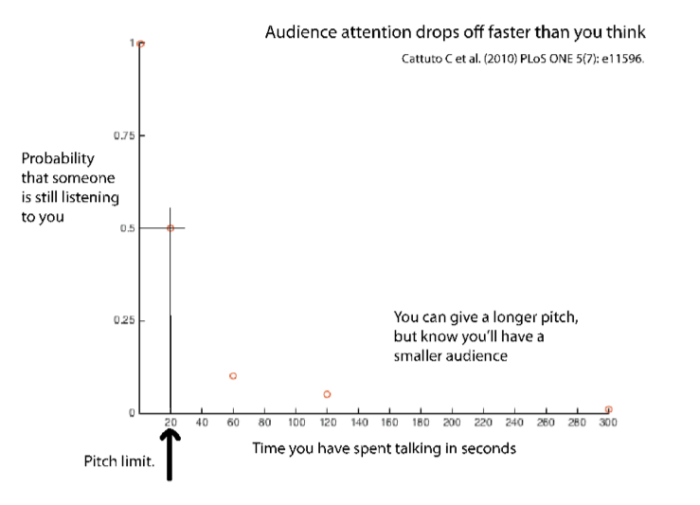Criteria for Success
A successful elevator pitch…
- Gets a stranger excited about your ideas.
- Uses simple language that is familiar to your audience.
- Concisely captures the impact and value of your work or idea.
- Executed in ~20 seconds.
Structure Diagram

Narrative Flow
- Intro – Who are you?
- Hook – What is the opportunity (problem)?
- Line – How do you seize (solve) it?
- Sinker – Why does this matter, how does this create value?
- Ask – Gauge their response, would they like to hear more or meet again?
Purpose
An “elevator pitch” can be any verbal description of who you are, what you do, and why you do it, but in all scenarios you have one purpose: secure the interest of the listener. It doesn’t matter if you are introducing a professor to your poster at a conference or just chatting with a friend: a successful pitch should draw them in to hear your whole story.
Analyze Your Audience
A successful pitch prompts the listener to respond, “Interesting—tell me more!” All decisions about content and delivery should be based on what will engage your audience.
Content
Select pitch content by answering questions like “what aspect of my work will be most exciting to my audience?” When preparing a pitch to a formal group, choose one aspect of your big problem and an application or advantage of your new idea that will interest the majority of the audience. When giving a pitch in a personal conversation, your pitch should be tailor-made for the specific person.
Delivery
Keep the sentence structure and words simple so that your delivery feels natural and your audience can follow the ideas you are presenting. The way we write is different from the way we speak. When drafting your pitch on paper, you might find that your sentences and words tend to be longer and more complicated. This structure is nearly always overly rigid for a pitch and will feel forced when you try to deliver it aloud. Furthermore, your audience will have difficulty following your ideas.
Skills
1. Keep it concise
Start by sketching a pitch. Don’t overthink it. Just jot down how you might respond to someone asking, “Hi. What are you working on? Why is it important?”
Listeners have a short attention span, so maximize your audience engagement by keeping your pitch to about 20 seconds. You may initially come up with something accurate and interesting, but too long and involved—iterate it.

To parse down your draft, cross out all the nonessential words until you feel you cannot cross out any more. Don’t worry about leaving complete sentences or phrases—push yourself to cut as much as possible. Now that you have a small handful of key words, insert as few words as possible to link together these concepts. Keep in mind that you are free to play with the order of your keywords, leave out some where you see redundancy, or even decide that you do not need them after all.
Author Tip: I find it easiest to start with the sentence about my project (highlighted in yellow) and then add the motivation pieces I need to create value for that idea.
Millions of people with foot amputation cannot afford high-quality prostheses. They have difficulty walking and become subject to social stigmas. I study human motion to develop metrics to design an affordable, high performance, passive prosthetic foot that will help them to walk naturally with less effort, improving their everyday life.
2. Use Simple Language!
People will not understand your pitch if you try to introduce too many new things. Look back at those key nouns and verbs previously identified and assess how your audience will relate to those words. Limit the number of definitions and jargon in your pitch.
Definitions
How many definitions—words followed by a clarifying phrase—are in your pitch?
You can keep one of those, but for the rest, toss the defined word or phrase and keeping the clarifying phrase.
Recovery ratio, the volume of drinkable desalinated water compared to the seawater volume used to produce it, is a key determinant of the performance of these systems.
Jargon
Are there any specific terms that you think your audience will not understand? We will call those words “jargon.” They need to be replaced or removed.
There is “obvious jargon,” which refers to words completely foreign to your audience, such as “NPTF tap” or “National Pipe Thread Fuel tap.” These are useful in highly specialized arenas but are not helpful for most audiences. Often you can substitute these words with less specific words or cut them from the pitch altogether.
Avoid ambiguous words—words that have a different definition in your field than they do in to general population. For example, the meaning of “work” in the physics sense is quite different from the common use of this term by the general population. Though the word “work” is not foreign to an audience of non-scientists/engineers, it may still trip them up if you mean to use it in the physics sense. Using these words will not only lead to a miscommunication, but will be a distraction from your pitch.
3. Practice!
In conversation, we change our energy, speed, and volume naturally when speaking casually. In more formal settings, our focus or our nerves can make us fall flat and bore our audience. Practice the delivery dynamics, facial expression and body language . Give your serious, concerned face when you talk about your big problem. Pick up the energy when you introduce your ideas. Smile when you share your vision for a better future.
And lastly, practice—again and again!
